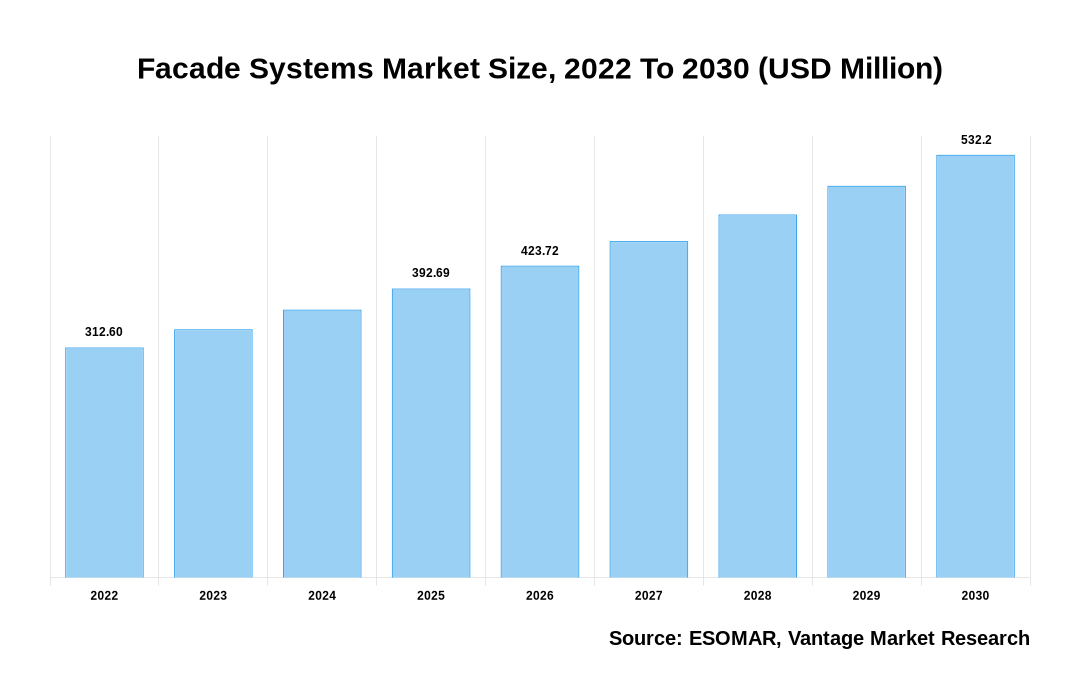Global Facade Systems Market
As stated in our extensive report; the Global Facade Systems Market accounted for USD 218 Billion in the year 2022 and is forecast to reach USD 532.2 Million by 2030 at a CAGR of 7.9%.
The market for Facade Systems, which consists of a variety of goods and services used in building design and construction, is one that is expanding quickly. Building exteriors are created using Facade Systems, which might include cladding, glass, sunshades, louvres, and ventilation systems.
Click To Get a Free Sample On the Research Study

A number of variables, such as energy efficiency, sustainability, aesthetics, technological improvements, and governmental restrictions, are what drive the market for Facade Systems. As building owners and developers look to cut costs and enhance building performance, energy efficiency is a key market driver. Due to the rising need for sustainable building methods and materials, sustainability is another major market driver.
Market segments are created based on product type, material type, and end-use industry. Glass, metal, stone, and concrete are the most frequent materials utilised in Facade Systems. Products can be as simple as cladding panels or as intricate as systems that combine glazing, louvres, and ventilation systems. Commercial, residential, industrial, and institutional buildings are some of the end-use sectors for Facade Systems. Commercial buildings require high-quality and aesthetically pleasing facades to draw tenants and consumers, making this sector the largest end-use market for Facade Systems.
Factors Influencing Global Facade Systems Market Growth
- Energy Efficiency: Building owners and architects are increasingly seeking for façade solutions that can help lower energy consumption in buildings as a result of the rising cost of energy. Building energy consumption is decreased by Facade Systems’ insulation and reduction of heat gain and loss. As a result, there is a rising need for Facade Systems that are created to be energy efficient.
- Design and Aesthetics: Facade Systems are essential to a building’s overall appearance and design. Building owners and architects are searching more and more for creative and distinctive ideas that will set their structures apart. There is a growing market for specialised Facade Systems that are aesthetically pleasing and work with the overall building design.
- Sustainability: The building sector is becoming more and more concerned with this issue. As a result, more home builders and real estate investors are implementing Facade Systems that adhere to sustainable building guidelines. Environmentally friendly materials can be used to create Facade Systems, and these systems can be created to lessen the environmental effect of a structure.
- Urbanization and Population Growth: There is a greater need for commercial and residential structures as a result of the world’s increasing urbanisation and population expansion. As a result, there is a rising demand for sturdy facade solutions that can satisfy the needs of contemporary structures.
- Technical Developments: New, creative Facade Systems that are more effective, robust, and sustainable have been created as a result of technological advancements. Facade Systems that can adjust to changing weather conditions and offer more insulation are being developed using new materials, such as composite materials and smart glass.
- Government Policies: The market for Facade Systems is significantly impacted by government regulations. The demand for Facade Systems that adhere to these criteria is being fueled by the updating of building rules and laws in many nations to encourage energy efficiency and sustainability.
There is a need for regular routine maintenance of various Facade Systems, including cladding, curtain walls, sidings, and EIFS, in order to preserve water tightness and lengthen longevity. Also, it’s crucial to get rid of the dust particles that have gathered on the systems’ surfaces because they can aid stop organic growth. If a component of the Facade Systems is cracked or dented, it is getting harder to fix it. Also, if professionals are not involved in the repair and maintenance process, the claddings, which are primarily comprised of metals, are readily dented. Thus, the cost and duration of repairs could provide a significant obstacle for Facade Systems.
Asia Pacific Region to Take Over the Market
The Asia Pacific region is predicted to dominate the Facade Systems market due to the region’s rapid industrialization and urbanisation, which is being fueled by the availability of cheap labour and land. As a result, the region’s construction activities are expanding, which is driving up demand for high-quality and long-lasting Facade Systems in nations like China, Japan, and India. The region’s expanding building development projects, notably in the commercial and residential sectors, are another factor driving the Asia-Pacific market.
Conclusion
In conclusion, the market for Facade Systems is expanding and is being driven by elements including energy efficiency, sustainability, aesthetics, modern technology, and governmental restrictions. The market is anticipated to keep expanding as a result of the rising demand for cutting-edge, high-performance Facade Systems that may lower energy consumption, boost building performance, and improve buildings’ visual appeal. Due to the region’s rapid urbanisation, population expansion, and rising demand for high-quality and durable Facade Systems in nations like China, Japan, and India, the Asia-Pacific region is predicted to dominate the Facade Systems market. The demand for energy-efficient and sustainable buildings, the adoption of modern architecture, and the tight building laws and regulations in these areas are all contributing to the rise in demand for Facade Systems.
Some of the prominent players in the Global Facade Systems Market include- Rock Panel Group (Netherlands), Apple (U.S.), Bouygues (France), Enclose (U.S.), Kingspan Group (Dublin), Gartner (Parameterise Group), Hansen Group (U.S.), Hochstein (Germany), National Enclosure Company LLC (U.S.) and others.
![[Market Research Reports] – Research Google News Blog | VMR.Biz](https://www.vmr.biz/wp-content/uploads/2022/12/logo-removebg-preview.png)











